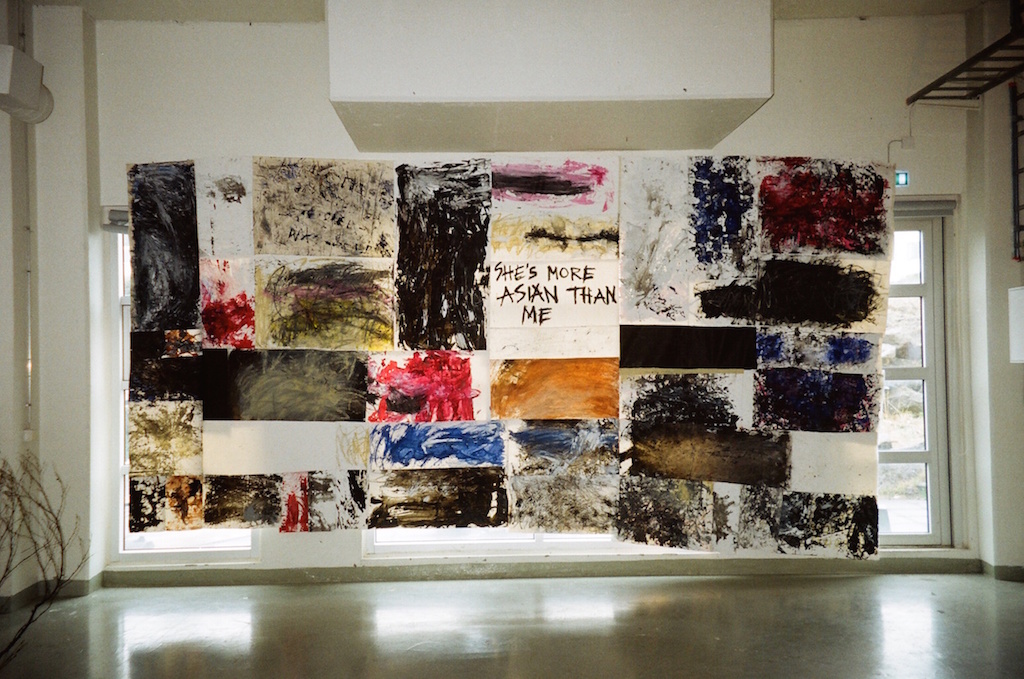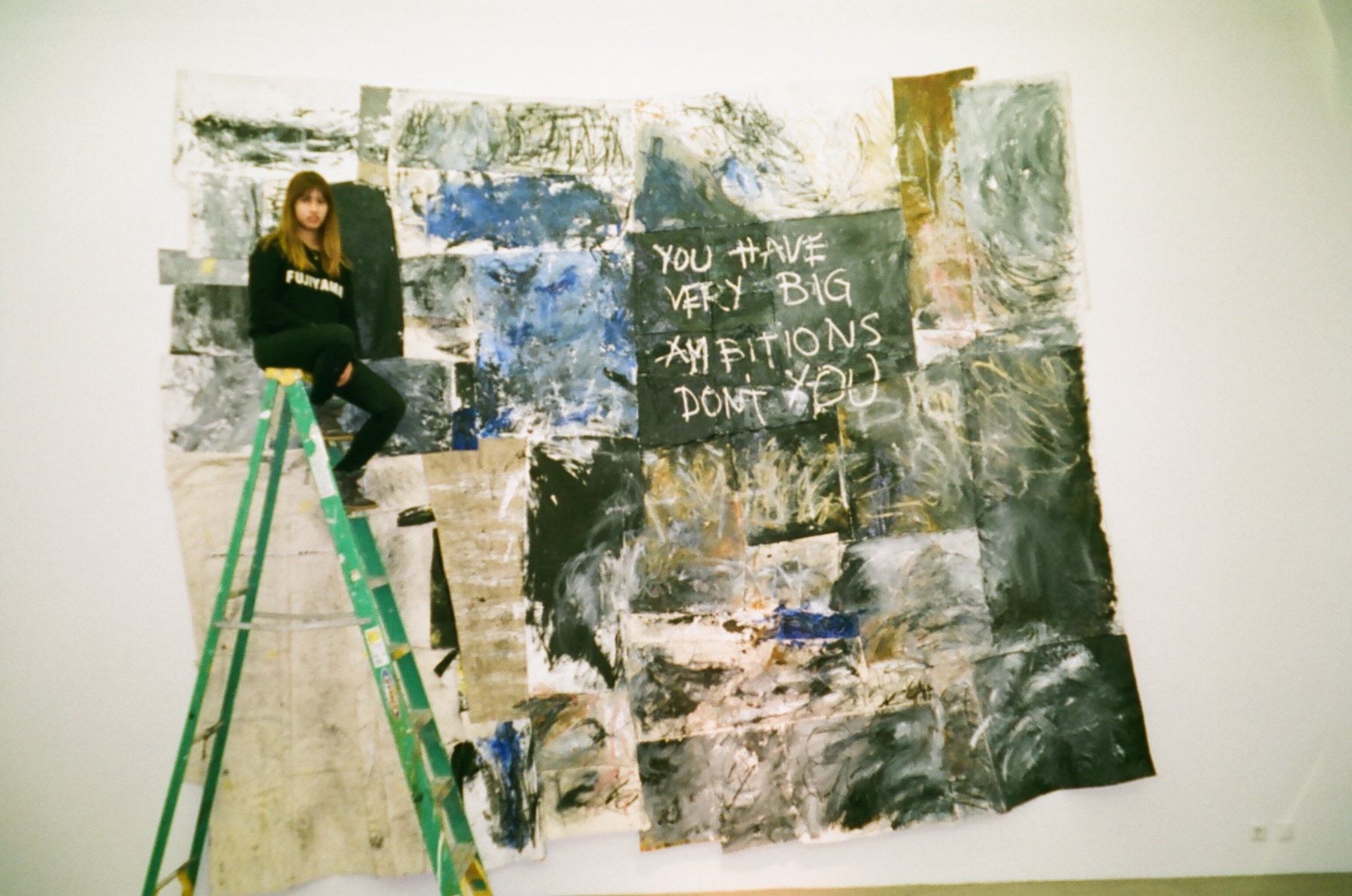Born in the Philippines and raised in Iceland, Ubaldo has lived on the Nordic island for more than half of her life and is now based in Reykjavík. It’s a journey that has inspired her considerably as an artist and laid the foundation for most of her work.
Ubaldo describes her work as intimate, monumental, and provocative to the audience. The enormity of her work juxtaposes the delicate methods she uses. With personal billboards embodying immense detail, she publicizes the private. “I’m lucky enough that people are rude, misogynist, and racist to me – I keep it in my sketchbook for later use,” Ubaldo states sarcastically. Social interaction and text play enormous roles in Ubaldo’s work, this is how she transforms negative social experiences into visual art.
With a Bachelor of Fine Arts from Listaháskóli Íslands (Iceland University of the Arts) and a keen interest in written word and architecture, Ubaldo combines all of these aspects in her art. She also belongs to a collective called Lucky 3.
We spoke to Ubaldo about the social aspect of her work, Lucky 3, and the source of her inspiration:
How did your art come to be the visual art you do now?
When I was in the first semester of my Fine Art BA, I was already doing figurative large-scale paintings. I was mostly painting people.
I was reminded of a very distant memory from my childhood in the Philippines. My mom, like most of the ladies in the neighborhood, had a side hustle where she would take shredded materials or textiles and sew them together into rags. They are circular and look like flowers. It’s a common thing in the Philippines that poor kids would knock on car doors and try to sell them in traffic jams.
Inspired by this childhood memory, I took the biggest painting I had done at that time and shredded it, just tore it apart. After that, I started sewing it back together again – then I just continued.
 | |
 |  |
Text plays a prominent role in your work, can you tell me a bit more about where the quotes come?
The quotes in my work are all autobiographical, things that have been said to me throughout my life, which came very serendipitously to me while studying. Somehow I was just lucky enough to have these words uttered to me and whatever meaning they had then helped me get them into the artwork itself.
In my practice, text and image are inextricably linked. When people say something to me I’ll write it in my sketchbook. Words and text are the most significant conceptual foundation of my work, and the painting is to bring in a visual element. It’s a struggle because sometimes I think should I make a painting? Or should I do text work straight on a wall? Does it have to be together all the time? I like seeing it that way.
What is the intended effect?
I like to imagine the pieces I make as personal billboards. They’re such an eyesore and they’re everywhere, so why not borrow this aesthetic of consumer culture? They’re constantly reminding us to replicate, consume, and buy.
You’ll go to a show and there you see my painting, which is enormous and with a tagline. It’s an instant visual experience, much like a billboard – it pops out, it’s in your face, easy to digest, and it contains the irony that it comes from a bad moment or experience.

I’m publicizing these negative moments for a crowd, which makes me wonder if I’m subconsciously inviting people to pry upon my misfortunes. Especially for the art audience’s intellectual entertainment. There is always some emotional capital that I put into my art. This emotional capital, in a way, underpins the business of art consumption.
You are a part of a collective called Lucky 3, can you tell me a little bit more about that?
Lucky 3 is composed of me, Dýrfinna Benita Basalan, and Darren Mark. We all share common origins from the Philippines. We joined forces for an exhibition about our shared memories of the Philippines and reconstructed a nostalgic representation of Filipino culture. We named the exhibition ‘Lucky me?’ – a play on the popular noodle brand ‘Lucky me!’ The event was first and foremost a celebration of Filipino culture and immigrants in Iceland.
It was our first show and a passion project. We sent proposals everywhere and luckily Kling&Bang picked it up, so we got a grant for the exhibit. I think that the lack of minority exhibitions stems from the fact that nobody even dares to ask for grants.
The dream is to grow the collective and get in touch with more Filipino artists and creatives in Europe. There are a lot of Asian collectives in the US, but none that I know of in Europe, maybe in the UK and London there is something, but I’m not sure.
 |  |
 | |
What is next for you and how can people find you
I have two projects coming up: a piece for platform Gátt which is a multidisciplinary artist collaboration within the Scandinavian countries; and a collaboration with the Reykjavík public library focused on inclusivity, which is called Inclusive PublicSspace. It’s very exciting and will hopefully come to fruition. (Projects are subject to change due to the measures brought in to prevent the spread of coronavirus)
People can find out more about my past and upcoming work on my website.

